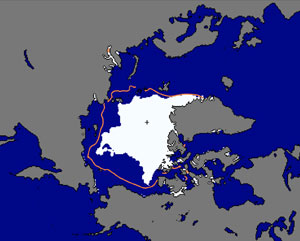In late August, sea ice extent was way below average for that time of year, and it was predicted we were headed for at least a near-record low this year. Those predictions have, unfortunately, turned out to be true. On September 9, sea ice extent reached its yearly minimum, the second lowest since satellite records began in 1979 – and so close to the record low in 2007 that it’s a statistical tie.
NASA has posted series of pictures of sea ice this year taken by its Aqua Earth-observing satellite. Here’s the Arctic ice as it was in March (top) and September 2011 (bottom):
They put together a series of the images into an animation that really gives you a clear picture of what’s going on:
Of course, you expect more ice in the winter and less in the summer and fall, so by itself those pictures don’t tell you what this means. You need to compare the current extent with how things were in the past. As it happens, the National Snow and Ice Data Center in Boulder does just that.
 This graphic by the NSIDC shows the north pole (you can see North America at the bottom, Greenland to the right, and Asia at the top) with the ice extent on September 9, 2011 marked in white. The orange line marks the median extent of the ice from 1979 to 2000 as measured on September 9 of each of those years. Putting a number on this, the current extent is nearly a million square miles less than that median value.
This graphic by the NSIDC shows the north pole (you can see North America at the bottom, Greenland to the right, and Asia at the top) with the ice extent on September 9, 2011 marked in white. The orange line marks the median extent of the ice from 1979 to 2000 as measured on September 9 of each of those years. Putting a number on this, the current extent is nearly a million square miles less than that median value.
Yikes.
How bad is this? Well, from what I can tell, it’s not good. In 2007, the sea ice cleared enough that the Northwest Passage became navigable by ship without the help of an icebreaker for the first time in recorded history. We’re there again right now. And it’s not just extent – that is, the area covered by ice – it’s also the volume: that’s at the lowest amount on record this year as well.
As pointed out above, the lack of ice means that the northernmost latitudes are able to be plied by ships in the summer. But every year there is less ice even at maximum, meaning more and more area is accessible year-round. It’s well-known that there are deposits of oil and natural gas up there, and of course the oil companies want access to them. That’s why it’s particularly interesting that Exxon is investing billions of dollars in offshore drilling there, in places previously not accessible due to ice (full disclosure: that article was written by my nephew-in-law Chris Jones). In other words, even Exxon is putting its money where its mouth is, saying not only is global warming real, but that its effects will be around for a while.
I have no grand conclusions here, no line in the sand to draw. This is simply yet another data point in an increasingly long line of evidence showing global warming is real, along with all the evidence that it’s getting worse, we’re causing it, and the spin against it by the deniers is approaching light speed. The Related Posts links below make all that clear.
I just hope that by talking about this, more and more voters will listen. In a very real sense, what happens next is up to us.
Image and video credits: NASA’s Scientific Visualization Studio, Goddard Space Flight Center; National Snow and Ice Data Center
Related posts:
- Arctic sea level ice will be below average again this year
- Sea level rise has slowed… temporarily
- NASA talks global warming
- Our ice is disappearing
- Dramatic glacial retreat caught by NASA satellite
- Case closed: “ClimateGate” was manufactured